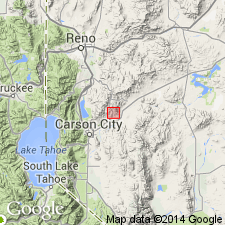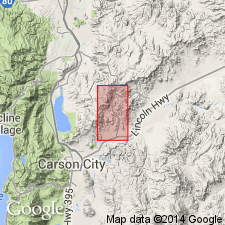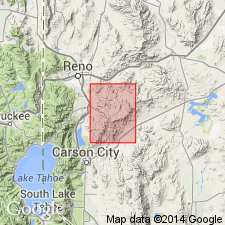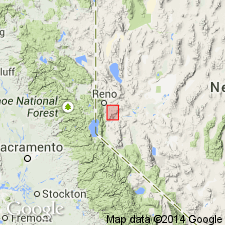
- Usage in publication:
-
- Alta andesite series
- Modifications:
-
- Named
- Dominant lithology:
-
- Andesite
- AAPG geologic province:
-
- Great Basin province
Summary:
Alta andesite series is named for rocks exposed both on the surface and underground near the Alta shaft, Silver City district, Storey County, [Virginia City 15-min quadrangle], Nevada. Previously called the Forman andesites (citing Gianella, 1934). Contains Sutro tuff member (new). Breccias predominate in lower part of the series; amount of lava increases toward top of series. Fresh rock is light greenish-gray to dark gray, and dark green; breccia mottled with blotches of red and green; weathered rock is gray, green, yellow, buff, and red. Maximum thickness is estimated to be over 3,600 feet. Overlies Hartford rhyolite (new). Age is possibly from Eocene to Miocene, on the basis of stratigraphic position; author's opinion is Miocene.
Source: Modified from GNU records (USGS DDS-6; Menlo GNULEX).

- Usage in publication:
-
- Alta andesite*
- Modifications:
-
- Adopted
- Revised
- AAPG geologic province:
-
- Great Basin province
Summary:
Alta andesite series of Gianella (1936) is adopted as Alta andesite. Unit is divided into four subunits (ascending): hornblende-pyroxene andesite, lava and breccia (600 feet); water-laid sediments, shaly to conglomeratic in texture (Sutro member; 300 feet); pyroxene andesite, mostly lava (800 feet); hornblende-pyroxene andesite, mostly lava (1000+ feet). Age is Miocene on the basis of fossils [leaves] and stratigraphic position.
Source: Modified from GNU records (USGS DDS-6; Menlo GNULEX).

- Usage in publication:
-
- Alta formation*
- Modifications:
-
- Redescribed
- Age modified
- Dominant lithology:
-
- Andesite
- Trachyte
- AAPG geologic province:
-
- Great Basin province
Summary:
Alta andesite is redescribed as Alta formation. Unit is pyroxene tuff-breccia in type, but ranges in composition to soda trachyte in Steamboat Valley. Age is Oligocene(?) on the basis of fossils [leaves] found in the Sutro member (citing Axelrod, 1949).
Source: Modified from GNU records (USGS DDS-6; Menlo GNULEX).

- Usage in publication:
-
- Alta Formation*
- Modifications:
-
- Age modified
- AAPG geologic province:
-
- Great Basin province
Summary:
Alta Formation is early or middle Miocene in age based on K-Ar ages of 16.5 +/-0.5 Ma (citing Silberman and McKee, 1972) and 14.4 +/-0.4 Ma and stratigraphic position [K-Ar ages not recalculated].
Source: Modified from GNU records (USGS DDS-6; Menlo GNULEX).
For more information, please contact Nancy Stamm, Geologic Names Committee Secretary.
Asterisk (*) indicates published by U.S. Geological Survey authors.
"No current usage" (†) implies that a name has been abandoned or has fallen into disuse. Former usage and, if known, replacement name given in parentheses ( ).
Slash (/) indicates name conflicts with nomenclatural guidelines (CSN, 1933; ACSN, 1961, 1970; NACSN, 1983, 2005, 2021). May be explained within brackets ([ ]).

